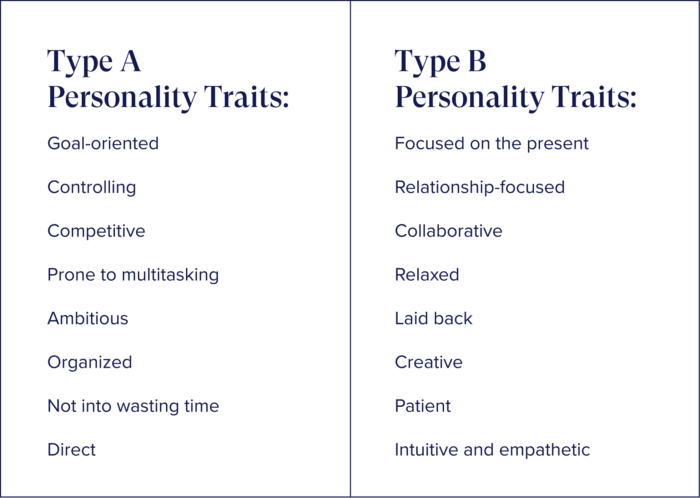The workplace is a source of wildly differing social interactions. It can be a place of bullying, bias, and bad bosses. But it can also bring positive interactions in the form of mentorship, friendships, and connection with like-minded people.
So how can you manage different personalities (including your own) at work, to help create a career and culture you love? That’s what we’re here to explore.
Type A vs. Type B Personalities
You may have heard about ‘Type A’ and ‘Type B’ personalities before. (Perhaps you’ve already been pegged as one or the other.)
It’s worth mentioning that most modern psychologists recognize more than just two personality types. The Myers-Briggs Type Indicator breaks it up into 16 types, while The Big Five lists five key traits.
But many people relate to the difference between a Type A and Type B, and you can generally find examples of each in every workplace.

You may relate to some Type A traits and some Type B traits, but most people lean more towards one side.
So let’s look at the strengths and weaknesses of both types, and how they can be managed in the workplace.
How to handle a Type A Personality
If you relate more to a Type A personality yourself, you might be more competitive, organized, perfectionistic and goal-oriented at work.
While this can make you a highly productive and efficient worker, there are some things you should watch out for:
- Burnout – Type A’s are prone to work addiction and toxic productivity behaviours. Not only can this affect your mental health, it can lead to frequent physical sickness too. (In fact, the whole Type A/Type B system is based on research in the 1950s into how Type A personality correlates with coronary heart disease.)
- Success obsession – Due to perfectionistic tendencies, you may feel more impacted by failures or setbacks. But these are inherent in everyone’s career. Try to learn how to deal with failure gracefully – it’s a key learning for life!
- Agitation and impatience – If you find it hard to wait on other people to get work done, you might struggle with situations out of your control. Type A’s need to learn to take a step back. Agitation can lead to aggressive behavior, and impatience can lead to rushed work.
Finding success in the workplace as a Type A
Aligning with a Type A personality isn’t a bad thing. In fact, Type A’s are often more suited to leadership opportunities due to their efficient nature, their ability to make decisions, and their talent for delegating tasks.
Here are some things you can do to draw on your strengths and offset any negative Type A qualities at work:
- Get comfortable with delegating and relinquishing control.
- Set boundaries for yourself (i.e. leave the office by 6pm, don’t work weekends).
- Gamify your workload where possible – Type A’s thrive in competitive scenarios.
- Inconvenience yourself. This will force you to get a hold of impatience or agitation. Stop to talk to colleagues now and then, and listen to others’ ideas in meetings even if it slows things down.
- Use your team. You may prefer to work on your own, but learning to collaborate with a team is vital for career success.
Tips for managing a Type A
Got some Type A personalities on your team? Here are some tips for getting the most out of them.
- Promote them – Type A’s are decisive, direct, and tend to do well in leadership roles.
- Give them autonomy – Type A’s thrive in fast-paced environments where they can make decisions fast.
- Force them to take breaks – Type A’s tend to overwork, and this can lead to burnout. Stress management is essential for Type A’s.
- Encourage goal-setting – Type A’s can benefit from a clear roadmap and KPIs so they know what they’re working towards.
How to handle a Type B Personality
If you relate more to a Type B personality, you might be more relaxed, creative and reflective at work, focused on collaborating and building positive relationships with colleagues.
Your creativity and big-picture thinking can be an asset, but here are some things to watch out for:
- Procrastination – Type B’s can find it hard to stay focused on one task, and distractions come easily. Time management techniques such as time blocking may help you stay on task.
- People pleasing – Being liked and valued is important to Type B’s. But make sure this doesn’t come at the cost of doing good work, or allowing yourself to be unfairly treated.
- Not following through – Caught up in big-picture, creative mode, Type B’s may struggle to see work through to completion before getting bored and jumping onto the next thing. This can take time to work on, and enlisting a mentor or accountability partner can help you achieve this.
Finding success in the workplace as a Type B
You may not subscribe to the ‘hustle culture’ that many Type A’s easily fall into (making them great leaders and entrepreneurs), but being a Type B can make you a valuable asset to an organization.
Here are some ways you can use your strengths to advance in your career:
- Build your discipline and focus. Find ways of working that suit you and allow you to get tasks completed with minimal distraction. Some Type B’s get more work done when working from home, while others stay focused in an office.
- Practice organization, whether it be by engaging productivity apps, project management tools, or to-do lists.
- Don’t write off management opportunities. Victor Lipman, author of The Type B Manager, advocates for promoting Type B’s due to their strong people management skills.
- Bring people together. Your collaborative approach to work can help you connect ideas, projects and departments. (But remember, people don’t like unnecessary time-wasting meetings!)
- Motivate, develop and build up others. This is a skill you can use throughout your career to obtain workplace sponsors and loyal team members.
Tips for managing a Type B
Team members with Type B tendencies may be difficult to keep engaged in work, or have a different sense of urgency to others, but they’ll add much-needed diversity and perspective. Here are some ways you can manage them effectively:
- Equip them with time management techniques – time tracking tools and techniques can help a Type B stay on task.
- Recognise and value their input – Type B’s love appreciation, and respond well to praise.
- Encourage them to share ideas – Respect their process, and Type B’s often come up with innovative ideas and creative solutions.
- Give them complex tasks – Bill Gates said, “I choose a lazy person to do a hard job. Because a lazy person will find an easy way to do it.” (But note: Type B’s aren’t necessarily ‘lazy’, just usually more relaxed in their approach. This can mean they’ll seek out simple solutions rather than overthinking it.)
- Watch out for people-pleasing behavior – Teach Type B’s to be assertive and push back when needed.
When we head into professional discussions or negotiations with a clear picture of how we and others are motivated and tend to operate, we can learn to work to our strengths and respect the process of other people. The result? Less disappointment and miscommunication, greater efficiency and mutual understanding.
We’d love to know what you think and if this has helped you reframe your relationships at work. Join the conversation online.





